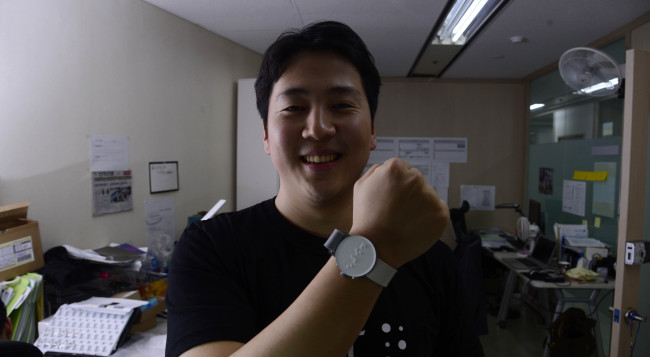[Design Forum] Entrepreneur seeks to bridge digital divide for the blind with design
By 이선영Published : Nov. 6, 2015 - 17:41
In this digital world, information is becoming increasingly easier to access. But not for all. Such accessibility still falls far short for people with disabilities.
Young entrepreneur Kim Ju-yoon has turned to the issue of discrimination in information accessibility and decided to tackle it with the power of technology and design. His belief in the fair distribution of digital benefits led him to create smartwatches for the blind that are light, affordable and as appealing as other smartwatches in the market.
Young entrepreneur Kim Ju-yoon has turned to the issue of discrimination in information accessibility and decided to tackle it with the power of technology and design. His belief in the fair distribution of digital benefits led him to create smartwatches for the blind that are light, affordable and as appealing as other smartwatches in the market.

The watch, still being developed at his start-up “Dot,” based in Seoul, has drawn attention in local and overseas markets even before its scheduled release next year.
“When I first saw assistive devices for the blind, I was shocked to find out there have been no remarkable changes or developments in terms of technology, function and price over the past decade. The blind have been on the sidelines of the digital world,” said Lee in an interview.
Kim has been invited to share his stories at the Herald Design Forum 2015 on Nov. 10 in Seoul.
Kim continued to explain that people with visual disabilities make up some 300 million people among about 500 million people with disabilities in the world. Just one percent of normal books are translated into Braille books. The price for digitalized Braille devices cost up to approximately $7,000, which leads many blind people to eventually give up on learning Braille. The illiteracy rate of the visually impaired population worldwide has reached 90 percent.
To lower the high illiteracy rate, he took action to make light, wearable smartwatches that work in Braille. The smartwatch, supported by iOS and Android, uses magnets and a grid of pins that shows Braille on the screen, through which blind people can access various texts such as messages and tweets anytime and anywhere.
Dot is also in the process of developing a smart pad in which blind people can read longer texts and study mathematics.
“Design matters the most here. Existing assistive devices for the blind are so huge and heavy. Carrying them obviously tells that the carrier is blind,” Kim said.
“I tried to get rid of the name ‘assistive device’ and just present a smartwatch that is no different than other smartwatches for those without disabilities.”
By Park Su-jin and Lee Woo-young
(sjp10@heraldcorp.com) (wylee@heraldcorp.com)









![[Kim Seong-kon] Democracy and the future of South Korea](http://res.heraldm.com/phpwas/restmb_idxmake.php?idx=644&simg=/content/image/2024/04/16/20240416050802_0.jpg&u=)







![[KH Explains] Hyundai's full hybrid edge to pay off amid slow transition to pure EVs](http://res.heraldm.com/phpwas/restmb_idxmake.php?idx=652&simg=/content/image/2024/04/18/20240418050645_0.jpg&u=20240418181020)

![[Today’s K-pop] Zico drops snippet of collaboration with Jennie](http://res.heraldm.com/phpwas/restmb_idxmake.php?idx=642&simg=/content/image/2024/04/18/20240418050702_0.jpg&u=)